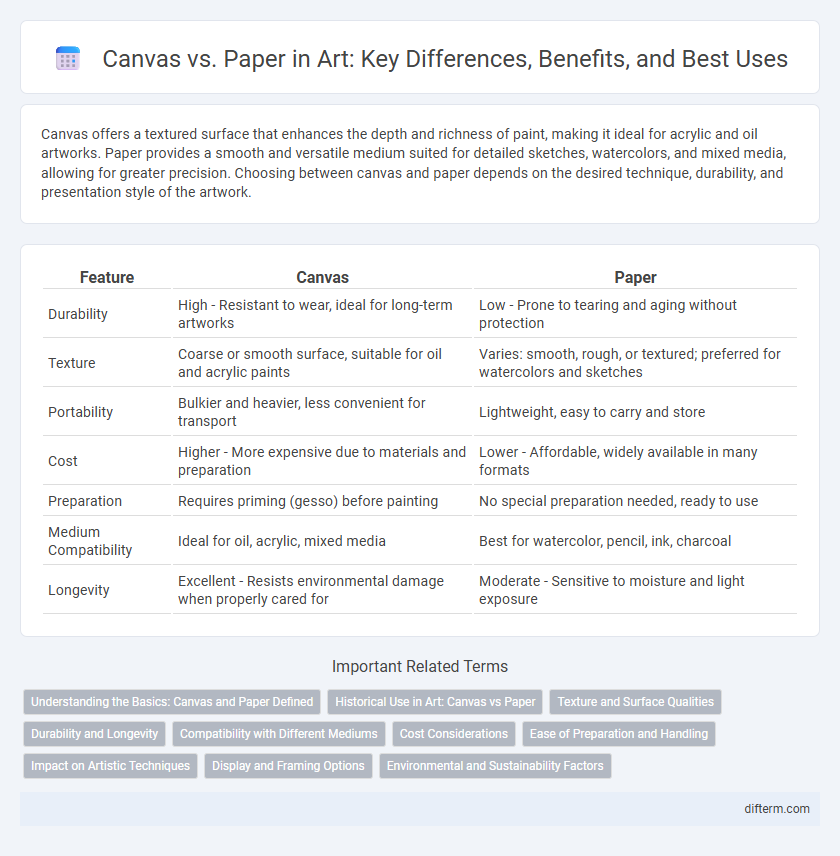Canvas offers a textured surface that enhances the depth and richness of paint, making it ideal for acrylic and oil artworks. Paper provides a smooth and versatile medium suited for detailed sketches, watercolors, and mixed media, allowing for greater precision. Choosing between canvas and paper depends on the desired technique, durability, and presentation style of the artwork.
Table of Comparison
| Feature | Canvas | Paper |
|---|---|---|
| Durability | High - Resistant to wear, ideal for long-term artworks | Low - Prone to tearing and aging without protection |
| Texture | Coarse or smooth surface, suitable for oil and acrylic paints | Varies: smooth, rough, or textured; preferred for watercolors and sketches |
| Portability | Bulkier and heavier, less convenient for transport | Lightweight, easy to carry and store |
| Cost | Higher - More expensive due to materials and preparation | Lower - Affordable, widely available in many formats |
| Preparation | Requires priming (gesso) before painting | No special preparation needed, ready to use |
| Medium Compatibility | Ideal for oil, acrylic, mixed media | Best for watercolor, pencil, ink, charcoal |
| Longevity | Excellent - Resists environmental damage when properly cared for | Moderate - Sensitive to moisture and light exposure |
Understanding the Basics: Canvas and Paper Defined
Canvas is a durable fabric, usually made from cotton or linen, stretched over a frame and primed to create a textured surface ideal for oil and acrylic painting. Paper, typically made from cellulose fibers, offers a smooth or textured surface suited for drawing, watercolor, and printmaking. Understanding these fundamental material differences helps artists select the best support for their medium, technique, and desired longevity of their artwork.
Historical Use in Art: Canvas vs Paper
Canvas gained prominence during the Renaissance as artists like Leonardo da Vinci and Titian favored its durability and texture for oil painting, revolutionizing fine art. Paper, used since ancient times, was predominantly employed for sketches, watercolors, and prints, prized for its portability and affordability. The historical shift from paper to canvas marked a pivotal evolution in art techniques and the preservation of artworks.
Texture and Surface Qualities
Canvas offers a textured, durable surface that enhances paint adhesion and allows for rich layering effects, making it ideal for oil and acrylic painting. Paper provides a smoother, more absorbent surface suitable for watercolor and ink, fostering fine detail and precision. The choice between canvas and paper depends on the desired texture, medium compatibility, and longevity required for the artwork.
Durability and Longevity
Canvas offers superior durability compared to paper, as its woven fabric structure resists tearing and warping over time. High-quality cotton or linen canvas, when primed with acrylic gesso, provides an acid-free surface that prevents yellowing and extends artwork longevity. In contrast, paper is more susceptible to environmental damage such as moisture, light exposure, and brittleness, making it less ideal for preserving paintings over decades.
Compatibility with Different Mediums
Canvas offers superior compatibility with oil paints, acrylics, and mixed media due to its durable, textured surface that holds pigments well and prevents warping. Paper is ideal for watercolors, ink, and pastels, providing smoothness and absorbency that support fine detail and delicate washes. Choosing the right support depends on the specific medium's requirements for texture, absorption, and durability to ensure optimal artistic results.
Cost Considerations
Canvas typically costs more than paper due to its durability and texture, making it a preferred choice for professional artists seeking long-lasting works. Paper is a budget-friendly option, ideal for beginners and studies, with prices varying widely based on weight and quality. Investing in canvas can increase the overall cost of art projects but often results in higher perceived value and longevity.
Ease of Preparation and Handling
Canvas offers greater ease of preparation due to its primed surface, allowing artists to start painting immediately without the need for additional treatment. Paper requires careful selection of weight and texture, often necessitating stretching or mounting to prevent warping during application. Handling canvas can be more convenient for framing and longevity, while paper demands gentle care to avoid creasing and damage.
Impact on Artistic Techniques
Canvas offers a textured surface that enhances the depth and vibrancy of oil and acrylic paints, allowing for techniques such as impasto and layering to create rich, dimensional effects. Paper, especially specialized types like watercolor or mixed media paper, supports delicate washes and fine detail work, making it ideal for watercolors, inks, and pencils. The choice between canvas and paper significantly influences brushstroke behavior, paint absorption, and the overall durability of the artwork.
Display and Framing Options
Canvas offers versatile display options with its thick, textured surface that can be stretched over wooden frames, creating a gallery-ready, frameless look that enhances durability and visual appeal. Paper, while more delicate, allows for a wide range of framing choices including matting and glass framing, which protect the artwork and add sophistication. The decision between canvas and paper greatly depends on the desired aesthetic and preservation requirements, with canvas suited for modern, minimalist displays and paper favored for traditional, formal framing.
Environmental and Sustainability Factors
Canvas typically offers greater durability and longevity compared to paper, reducing waste by preserving artwork for extended periods. Paper production often involves higher water consumption and chemical use, contributing to environmental strain, whereas canvas made from organic cotton or hemp can be a more sustainable option. Choosing recycled or sustainably sourced materials for both canvas and paper further minimizes ecological impact and supports eco-friendly art practices.
Canvas vs Paper Infographic

 difterm.com
difterm.com